同济大学 中西艺术比较课程-Presentation 7(英)
- 格式:ppt
- 大小:67.58 MB
- 文档页数:128

高校艺术学科师生海外学习计划同济大学佛罗伦萨校区佛罗伦萨学习中心暨纽约学习中心2014秋季海外学期教学通知为了促进中外高校艺术学科大学生之间的交流,提升中国艺术与设计类学生的国际视野与竞争力,同济大学与中国教育国际交流协会()借助同济大学佛罗伦萨校区、佛罗伦萨学习中心及纽约学习中心平台开办中国高校艺术学科学生2014秋季海外学期。
该项目选拔全国各有关院校艺术类、设计类专业在籍学生赴意大利或美国学习,通过一个学期的专业课程学习,让中国学生浸润全球顶尖艺术与设计创作氛围,从而在短时间内获得能力的有效提升.学生在完成意大利或美国大学所安排课程返回原校时,除了能够获得同济大学所提供的结业证明,还能够根据同济大学与相关院校前期签订的学分互认协议自动将海外学习所获学分对接入原籍所在学校学分系统。
一、主办机构中国教育国际交流协会中国教育国际交流协会()是中国教育界对外交流的全国性非营利机构。
协会建立30多年以来,成功与全球50多个国家和地区170多个教育组织和团体建立了交流合作关系,具有“联合国经社理事会特别咨商地位”和“联合国科教文组织咨商地位"双重资质。
同济大学同济大学( )是国家“211工程”和“985工程"重点建设高校.学校先后建立了8个国际合作平台,并与200多所海外高校签订合作协议,为XX直属的11个出国培训基地之一. 作为盟校在华核心成员,同济大学已连续3次被美国《商业周刊》评为全球最佳设计学院之一。
二、报名条件1、中国高等院校艺术学科(美术学类、设计学类与建筑学类)全日制在校生、研究生2、身心健康,品行端正,学习认真负责;3、具有独立生活能力和团队协作精神。
三、学科方向美术类:素描、油画、版画、雕塑、公共空间艺术、艺术摄影等设计类:时尚设计、环境艺术设计、视觉传达、产品设计、珠宝设计等建筑类:建筑美学、建筑设计、城市规划等ﻩﻩ四、课程设置通识实践类课程(艺术史、实验摄影、当代设计工作室等)专业拓展类课程(立体剪裁、零售空间设计、视觉传达的创意过程、创新材料和成品工艺等)五、授课语言秋季学期授课语言采取中英文相结合的方式;六、授课时间●纽约教学点:2014年8月-12月●佛罗伦萨教学点:2014年9月-1月注:具体开班时间请咨询项目办负责人七、授课地点意大利·佛罗伦萨美国·纽约州八、教学形式✧学习模式:结合授课()、参观体验( )、实习()和研讨交流()多种形式;✧师资团队:由海外合作院校提供教师担纲教授课程;✧学分管理:秋季学期学分在20学分左右,最少不低于15学分,其中包括4—5门课堂课程和1—2门实践课程.海外所修学分采用同济大学学分管理体系,将根据与学生原籍学校协议进行学分转移;✧结业证明:学生在顺利修完秋季海外学期应修学分之后将获得由同济大学所颁发的结业证书。
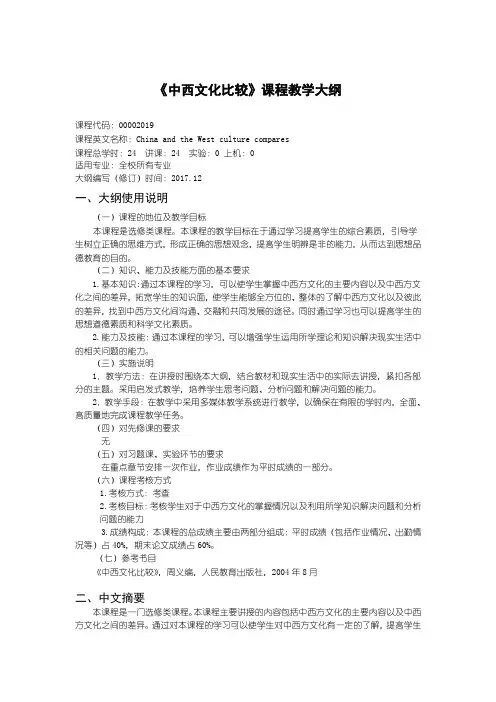
《中西文化比较》课程教学大纲课程代码:00002019课程英文名称:China and the West culture compares课程总学时:24 讲课:24 实验:0 上机:0适用专业:全校所有专业大纲编写(修订)时间:2017.12一、大纲使用说明(一)课程的地位及教学目标本课程是选修类课程。
本课程的教学目标在于通过学习提高学生的综合素质,引导学生树立正确的思维方式,形成正确的思想观念,提高学生明辨是非的能力,从而达到思想品德教育的目的。
(二)知识、能力及技能方面的基本要求1.基本知识:通过本课程的学习,可以使学生掌握中西方文化的主要内容以及中西方文化之间的差异,拓宽学生的知识面,使学生能够全方位的、整体的了解中西方文化以及彼此的差异,找到中西方文化间沟通、交融和共同发展的途径。
同时通过学习也可以提高学生的思想道德素质和科学文化素质。
2.能力及技能:通过本课程的学习,可以增强学生运用所学理论和知识解决现实生活中的相关问题的能力。
(三)实施说明1.教学方法:在讲授时围绕本大纲,结合教材和现实生活中的实际去讲授,紧扣各部分的主题。
采用启发式教学,培养学生思考问题、分析问题和解决问题的能力。
2.教学手段:在教学中采用多媒体教学系统进行教学,以确保在有限的学时内,全面、高质量地完成课程教学任务。
(四)对先修课的要求无(五)对习题课、实验环节的要求在重点章节安排一次作业,作业成绩作为平时成绩的一部分。
(六)课程考核方式1.考核方式:考查2.考核目标:考核学生对于中西方文化的掌握情况以及利用所学知识解决问题和分析问题的能力3.成绩构成:本课程的总成绩主要由两部分组成:平时成绩(包括作业情况、出勤情况等)占40%,期末论文成绩占60%。
(七)参考书目《中西文化比较》,周义编,人民教育出版社,2004年8月二、中文摘要本课程是一门选修类课程。
本课程主要讲授的内容包括中西方文化的主要内容以及中西方文化之间的差异。
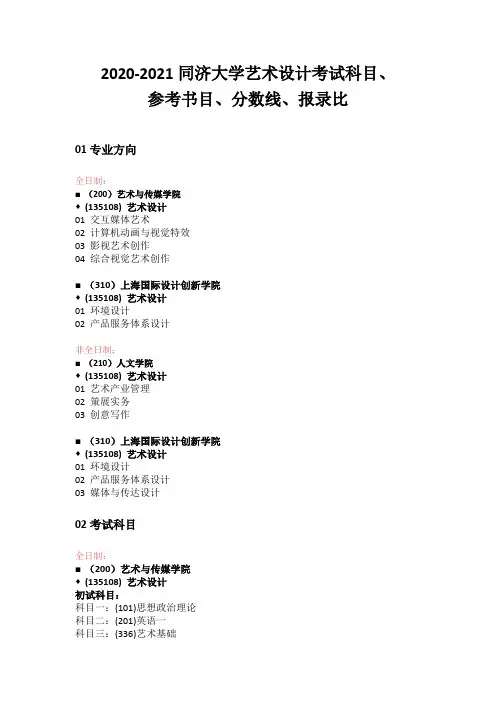
2020-2021同济大学艺术设计考试科目、参考书目、分数线、报录比01专业方向全日制:■(200)艺术与传媒学院◆(135108) 艺术设计01 交互媒体艺术02 计算机动画与视觉特效03 影视艺术创作04 综合视觉艺术创作■(310)上海国际设计创新学院◆(135108) 艺术设计01 环境设计02 产品服务体系设计非全日制:■(210)人文学院◆(135108) 艺术设计01 艺术产业管理02 策展实务03 创意写作■(310)上海国际设计创新学院◆(135108) 艺术设计01 环境设计02 产品服务体系设计03 媒体与传达设计02考试科目全日制:■(200)艺术与传媒学院◆(135108) 艺术设计初试科目:科目一:(101)思想政治理论科目二:(201)英语一科目三:(336)艺术基础科目四:(848)艺术创作复试内容:复试课名称:专业综合■(310)上海国际设计创新学院◆(135108) 艺术设计初试科目科目一: (101)思想政治理论科目二: (201)英语一科目三: (337)专业设计基础、(301)数学一任选一门科目四:(801)专业设计快题、(408)计算机学科专业基础综合、(812)机械设计、(823)电子学基础、(825)自动控制原理、(806)景观规划设计、(803)建筑设计任选一门复试内容专业综合设计非全日制:■(210)人文学院◆(135108) 艺术设计初试科目:科目一: (101)思想政治理论科目二: (204)英语二、(241)法语、(242)德语、(203)日语任选一门科目三:(640)艺术概论、(641)文学概论任选一门科目四: (872)创意写作(文案写作)复试内容:专业综合■(310)上海国际设计创新学院◆(135108) 艺术设计初试科目科目一:(101)思想政治理论科目二:(201)英语一科目三:(337)专业设计基础、(301)数学一任选一门科目四:(801)专业设计快题、(408)计算机学科专业基础综合、(812)机械设计、(823)电子学基础、(825)自动控制原理、(806)景观规划设计、(803)建筑设计任选一门复试内容专业综合设计03报考条件以上专业均不接受同等学力考生报考。


同济大学跨文化交流课文第二课Communication(textA)2. CommunicationText AA Wide-Angle View of CommunicationFrom birth to death, all types of communication play an integral part in your life. Whatever your occupation or leisure-time activities, communication of one form or another has a role. In fact, if people were asked to analyze how they spend most of their waking day, the prime responses would be “communicating”or “being communicated to”. In reality, communication is our link to the rest of humanity, But what is communication? And what is it we seek to accomplish with it? Let us begin to answer these questions by examining what we consider to be the essential ingredients of communication.Senders and ReceiversCommunication involves people who send and receive messages, sometimes simultaneously. This means that the role of sender or receiver is not restricted to any one party to the communication process; instead, we play both roles.There are times when it seems as if communication is predominantly one way: receivers of messages fail to react; senders of messages fail to consider the reactions of the receiver before sending another message. But for communication to be effective, the messages people send to others should, at least in part, be determined by the messages received from them.Field of ExperienceWe each carry our field of experience with us wherever we go. When the people communicating have had similar life experiences, chances are they will be able to relate to each otherin an effective way. However, to the extent that their life experiences have been different, they will probably have difficulty interacting with or understanding each other. As our storehouses of experience diverge, it becomes harder for us to share meaning. Conversely, as storehouses of experience converge, the sharing of meaning becomes easier.MessagesThe message is the content of a communicative act. People communicate a wide variety of messages. Some of these messages are private (a smile accompanied by an “I love you”), while others are directed at millions (a network television show, a mass-market paperback). Some messages are sent intentionally (“I want you to know”), while others are sent accidentally (“I didn’t realize you were watching me”). But as long as someone is there to interpret the results of a sender’s efforts, a message is being sent. Thus, we can say that everything a sender does or says has potential message value.Consequently, whether you smile, listen, renew a magazine subscription, watch a particular TV program, or turn away from a person, you are communicating some message, and your message is having some effect.ChannelsWe may send our messages to receivers through a variety of sensory channels. We may use sound, sight, smell, taste, touch, or any combination of these to carry a message. Some channels are more effective at communicating messages than others, and the nature of the channel selected affects the way a message will be processed. The impact of a message changes as the channel used to transmit it changes. Experience shows that most of us have channel preferences; that is, we prefer to rely on one ormore channels while disregarding others. Which channels are you most attuned to? Why? Adept communicators are channel switchers who recognize that human communication today is an ever-expanding, multichanneled event.NoiseNoise is anything that interferes with the ability to send and/or receive messages. Thus, while noise could be sound, it does not necessarily have to be sound. It could also be physical discomfort (a headache), psychological makeup (a poor self-concept, an inflated ego, or a high level of defensiveness), semantic misunderstandings (as when people give different meanings to words and phrases or use different words and phrases to mean the same thing), or the environment (a sparsely furnished room, a dimly lit office).The important point to remember is that noise can function as a communication barrier. As noise increases, the chances for effective communication usually decrease, and as noise decreases, the chances for effective communication usually rise. FeedbackFeedback returns information to the sender of a message, thereby enabling the sender to determine whether the message was received or correctly understood. There are at least three ways of looking at feedback.First, it can be positive or negative. Positive feedback encourages sources to continue sending similar messages; In contrast, negative feedback discourages sources from encoding similar messages.Second, feedback can be immediate or delayed; and third, it can be free or limited. In an immediate and free feedback condition, the reactions of the receiver are directly and freelycommunicated to and perceived by the source. At a political rally a speaker knows immediately whether the audience in the hall is friendly or unfriendly. In contrast, if you want to communicate your opinion of a newspaper article to the editor, before your views are received by the intended party, and printed, several days or perhaps even weeks might elapse.Feedback serves useful functions for both senders and receivers: it provides senders with the opportunity to measure how they are coming across, and it provides receivers with the opportunity to exert some influence over the communication process.EffectEvery communication has an outcome; that is, it has some effect on the personswho are a party to it, though the effect may not always be immediately observable. The consequence may be monetary, cognitive, physical, or emotional. For example, people may profit from the communication, or learn something, or alter their appearance or self-image.ContextFinally, every communication takes place in some context, or setting. Sometimes, the context is so natural that we fail to notice it; at other times, the context makes such an impression on us that we make a conscious effort to control our behavior because of it. For example, consider the extent to which your behavior would change if you were to move from a park to a political rally, to a movie theater, to a funeral home. Every context provides us with rules or norms for interaction. Sometimes place, time, and the people with us affect us without our being aware of it.。
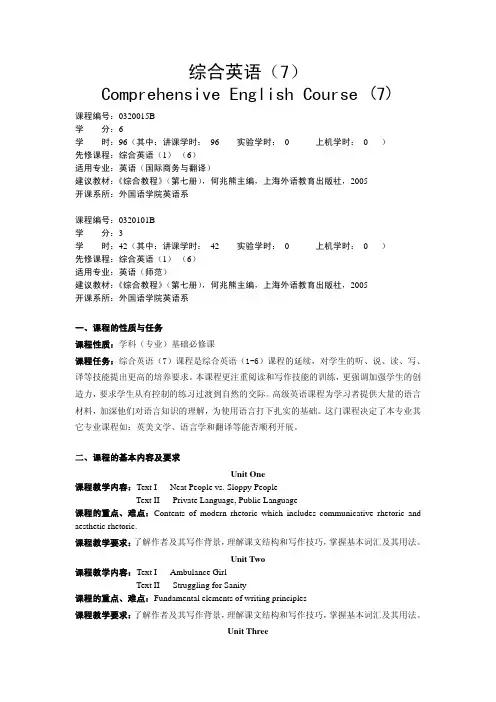
综合英语(7)Comprehensive English Course (7)课程编号:0320015B学分:6学时:96(其中:讲课学时: 96 实验学时:0 上机学时: 0 )先修课程:综合英语(1)-(6)适用专业:英语(国际商务与翻译)建议教材:《综合教程》(第七册),何兆熊主编,上海外语教育出版社,2005开课系所:外国语学院英语系课程编号:0320101B学分:3学时:42(其中:讲课学时: 42 实验学时:0 上机学时: 0 )先修课程:综合英语(1)-(6)适用专业:英语(师范)建议教材:《综合教程》(第七册),何兆熊主编,上海外语教育出版社,2005开课系所:外国语学院英语系一、课程的性质与任务课程性质:学科(专业)基础必修课课程任务:综合英语(7)课程是综合英语(1-6)课程的延续,对学生的听、说、读、写、译等技能提出更高的培养要求。
本课程更注重阅读和写作技能的训练,更强调加强学生的创造力,要求学生从有控制的练习过渡到自然的交际。
高级英语课程为学习者提供大量的语言材料,加深他们对语言知识的理解,为使用语言打下扎实的基础。
这门课程决定了本专业其它专业课程如:英美文学、语言学和翻译等能否顺利开展。
二、课程的基本内容及要求Unit One课程教学内容:Text I Neat People vs. Sloppy PeopleText II Private Language, Public Language课程的重点、难点:Contents of modern rhetoric which includes communicative rhetoric and aesthetic rhetoric.课程教学要求:了解作者及其写作背景,理解课文结构和写作技巧,掌握基本词汇及其用法。
Unit Two课程教学内容:Text I Ambulance GirlText II Struggling for Sanity课程的重点、难点:Fundamental elements of writing principles课程教学要求:了解作者及其写作背景,理解课文结构和写作技巧,掌握基本词汇及其用法。


Module 4 Fine Arts – Western, Chinese and Pop ArtsI.教材分析本节课是外研社第二册第四模块的课文,讨论的话题是西方艺术,中国传统艺术和波普艺术,涉及到一些与艺术相关的词汇。
本模块以Fine Arts – Western, Chinese and Pop Arts为话题,介绍了毕加索等数位著名的艺术家及其艺术风格,同时引入了与艺术和艺术欣赏有关的词汇。
通过模块教学,使学生了解这些艺术家及其艺术风格,并能用英语简单介绍自己喜爱的艺术家和艺术作品,从而提高学生的艺术欣赏能力,培养学生的文化意识和语言表达能力。
Reading and Vocabulary 部分分为两个部分,第一部分是词汇,通过词义配对,培养学生英语思维的能力,并初步扫清了阅读的词汇障碍;第二部分是阅读理解,先让学生看四幅画,通过这四幅画引出文章。
该文章是由六个段落组成,前面四个段落分别介绍了四位非常出名的艺术家,后两个段落是两个中学生对上面四幅画的评论和看法。
Function部分通过句子列出了交际中表达意见的语句,要求学生就自己喜欢的和不喜欢的艺术作品发表自己的看法,使学生掌握该交际用语。
Cultural Corner部分是一篇详细介绍毕加索的文章,通过对他三个时期作品的介绍,使学生更加了解这位世界著名的艺术家。
II.学情分析学生有了一定的英语基础,阅读问题不大,对艺术也感兴趣,但是学生对纯艺术了解不多、不深;对于各个艺术流派的特点和观念更是没有清晰的概念;描述画作的英语词汇缺乏;不知如何欣赏和评价一幅画;对毕加索的生平和艺术发展不甚了解。
III.教学目标1.知识目标:学会与艺术和艺术风格有关的词汇、短语和句式;能读懂课文获取主要信息。
2、能力目标:掌握基本的阅读方法和技巧,提高学生的阅读能力;能口头描述不同艺术风格的作品;能够简单评价一幅作品。
2.情感态度和价值观:增进对国内外艺术家及其作品的了解,培养学生的艺术审美意识,陶冶学生的艺术情操。

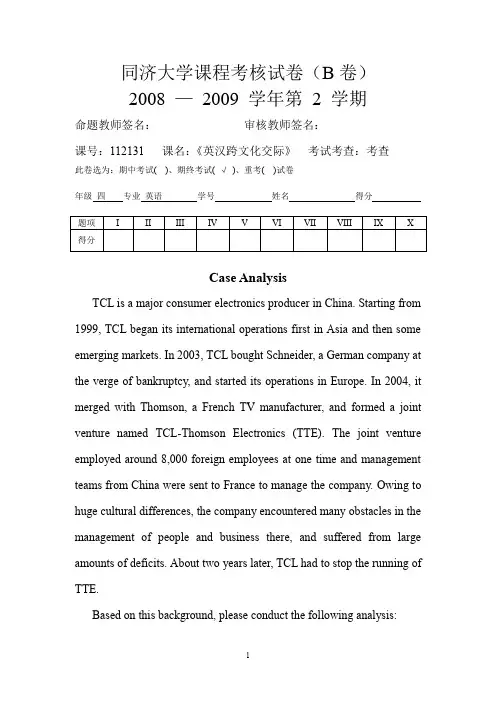
同济大学课程考核试卷(B卷)2008 —2009 学年第2 学期命题教师签名:审核教师签名:课号:112131 课名:《英汉跨文化交际》考试考查:考查此卷选为:期中考试( )、期终考试( √)、重考( )试卷年级四专业英语学号姓名得分Case AnalysisTCL is a major consumer electronics producer in China. Starting from 1999, TCL began its international operations first in Asia and then some emerging markets. In 2003, TCL bought Schneider, a German company at the verge of bankruptcy, and started its operations in Europe. In 2004, it merged with Thomson, a French TV manufacturer, and formed a joint venture named TCL-Thomson Electronics (TTE). The joint venture employed around 8,000 foreign employees at one time and management teams from China were sent to France to manage the company. Owing to huge cultural differences, the company encountered many obstacles in the management of people and business there, and suffered from large amounts of deficits. About two years later, TCL had to stop the running of TTE.Based on this background, please conduct the following analysis:1.Please give a brief account of TCL’s internationalization process andstate in which sense is intercultural communication important to businesses under the context of globalization.2.TCL’s failure in Europe may be attributed to many factors, but lack ofskills in intercultural communication is one of the key reasons. Please analyze TCL’s failure in Europe from the following perspectives:1)management style and corporate culture.2)work-related values and the function of the trade unions.3)differences in eastern and western cultures, particularlycollectivism and individualism.Your paper should be at least 1,500 words, and be filled with your own insights and perceptions.。
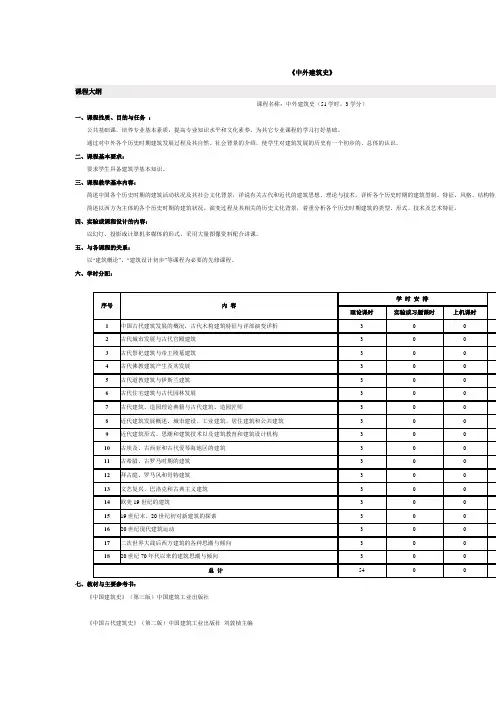
《中外建筑史》课程大纲课程名称:中外建筑史(51学时,3学分)一、课程性质、目的与任务:公共基础课。
培养专业基本素质,提高专业知识水平和文化素养,为其它专业课程的学习打好基础。
通过对中外各个历史时期建筑发展过程及其自然、社会背景的介绍,使学生对建筑发展的历史有一个初步的、总体的认识。
二、课程基本要求:要求学生具备建筑学基本知识。
三、课程教学基本内容:简述中国各个历史时期的建筑活动状况及其社会文化背景,详说有关古代和近代的建筑思想、理论与技术,详析各个历史时期的建筑型制、特征、风格、结构特点简述以西方为主体的各个历史时期的建筑状况、演变过程及其相关的历史文化背景,着重分析各个历史时期建筑的类型、形式、技术及艺术特征。
四、实验或课程设计的内容:以幻灯、投影或计算机多媒体的形式,采用大量图像资料配合讲课。
五、与各课程的关系:以“建筑概论”、“建筑设计初步”等课程为必要的先修课程。
六、学时分配:七、教材与主要参考书:《中国建筑史》(第三版)中国建筑工业出版社《中国古代建筑史》(第二版)中国建筑工业出版社刘敦桢主编《外国建筑史》(19世纪以前)中国建筑工业出版社《外国近现代建筑史》中国建筑工业出版社《外国建筑史图说》同济大学出版社《建筑物理(光)》课程大纲课程名称:建筑物理(光)(36学时,2学分)一、课程性质、目的与任务:公共基础课。
通过课堂讲授、一到两次课外实验和演示使学生掌握建筑光学的基本知识,为结合专业继续学习奠定基础,并使学生能适应今后工作中对建筑光学知二、课程基本要求:通过课堂教学,使学生了解建筑光学的基本概念,掌握天然采光的基本知识和计算方法、了解建筑照明的基本知识,掌握一般照明计算方法等。
三、课程教学基本内容:建筑光学分三大部分:第一部分为建筑光学基本知识,着重介绍与建筑有关的光学基本概况、单位和计算公式,并对建筑布局的光学特性作基本介绍。
第二部分为授我国光气候概论,各种采光窗的特性以及运用这些知识进行采光设计和采光计算。
民俗文化:朱桓夫(挺有学问的//不敢苟同,没什么其他意思,个人看法不同而已//水平不够?其实相对其他很多老师而言,朱的水准还是可以的//朱恒夫很强的,文学博士艺术学博士后的说~上课满有劲的,时常唱些小调给我们听,原来还是我们系主任呢~可是自从他关了我们家啊拽,我们就不点他了)品德修养:姚月(挺有水平//深有同感!!他讲的东西我现在还派的上用场呢:)//胖胖的)基础医学院:陈实(基础医学院最好最好最好的老师!!!!绝对灵,不仅学问好,人也好教书育人,没的说)地下系:艾智勇(没关过我们班级一个人)力学系:王俊民(没关过我们班级一个人)法律系:施洋(没关过我们班级一个人)物理系:华金龙(没关过我们班级一个人)流体力学:朱立明院长:陈以一土木学院建工系主任:顾祥林(次于某些院士的强人~~~)建筑学院:赵月(喜欢小男生,所以人特好),陈建伟(也哈灵的噢)混凝土:薛二乐(大学期间我学得最好的一门课,绝对牛人+好老师//绝对同意,举四肢赞成)顾祥林=============本部校区B.哲学与法学美国政治(英文授课)王传兴周三78 南118美国宪法判例选读吴宁周五78 北318欧盟对外战略蒋一澄周二78 北222周二910 北308佛教与中国传统文化张儒平周三78 北322社会学滕春海周三910 北219证券市场与证券法刘春彦周一78 北405宗教与文化胡春风周二78 南115房地产交易习惯与法律规制曹伊清周二78 南114物权法刘春彦周二9 10 北312现代商务礼仪罗鹏部周三78 北209孙子兵法及其应用曲秀君周三78 南119周三910 南322C.文学与历史(1)实践型中外剪纸艺术叶影周三9 10 北210美术素描周1 9 10和周三9 10 分单双周的具体哪个老师单/双周上课请到时去咨询要带画板铅笔画纸西南八地下有售铅笔买2B4B6B就好上课地点在建筑城规学院红楼(北楼北侧是文远楼,文远楼再北侧是红楼)的4楼靠北一排美术教室书法欣赏蒋荻周一9 10 南301篆刻欣赏蒋荻周二9 10 北313(2)名师/有趣型同济大学史江洪波周四7 8 北405 江老师据说上课超级有趣而且给分很厚道考试题目最后一题是问这门选修课的老师名字叫什么- -20世纪中国风尚史朱大可周四7 8 北209 朱大可真的很有名。